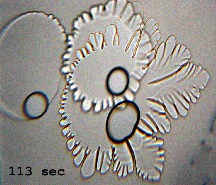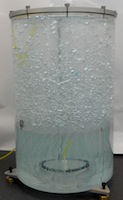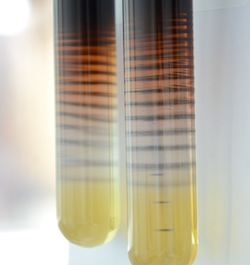 Tyndall stars: liquid snowflakes in superheated ice crystals. Radiant energy (i.e. light) can internally heat crystals of water-ice, bringing the ice above its freezing point and causing internal melting. Melt initially forms in disk-shaped pools that are oriented normal to the c-axis of the hosting crystal. Contraction of water on melting causes cavitation and the formation of a bubble within the melt pool. If the crystal around the liquid disk is heated above its melting temperature, the melt pool grows unstably, leading to the emergence of "liquid dendrites" in a snowflake pattern. This instability is analogous to the Mullins-Sekerka instability of a supercooled melt. The project started as Matt Hennessy's MSci thesis; working with Peppin and Katz, he did stability analyses, laboratory experiments, and numerical simulations (using the level-set method). This summer (2011) we are revisiting and extending all aspects of the thesis.
Tyndall stars: liquid snowflakes in superheated ice crystals. Radiant energy (i.e. light) can internally heat crystals of water-ice, bringing the ice above its freezing point and causing internal melting. Melt initially forms in disk-shaped pools that are oriented normal to the c-axis of the hosting crystal. Contraction of water on melting causes cavitation and the formation of a bubble within the melt pool. If the crystal around the liquid disk is heated above its melting temperature, the melt pool grows unstably, leading to the emergence of "liquid dendrites" in a snowflake pattern. This instability is analogous to the Mullins-Sekerka instability of a supercooled melt. The project started as Matt Hennessy's MSci thesis; working with Peppin and Katz, he did stability analyses, laboratory experiments, and numerical simulations (using the level-set method). This summer (2011) we are revisiting and extending all aspects of the thesis.
People: Harvey, Hennessy, Peppin, Katz. Related publications: Hennessy's MSci Thesis.

Gas percolation through a granular, viscoelastic medium. Beneath silicic volcanos, gasses released from crystallising magma rise buoyantly, by some combination of flow in fractures and bubbles. This process has been implicated in triggering eruptions of a range of sizes, but the physical mechanism connecting degassing and eruption is poorly understood. We're developing an analogue for degassing of a partially crystalline, silicic magma chamber. Our experiments involve the injection of air through an array of capillary tubes into a chamber filled with aqueous-polymer gel grains. Individually the grains are elastic, but together they form a viscoelastic matrix. We expect a range of behaviours including bubbling and porous flow. We will measure the relationship between gas influx and outflux through time, as well as acoustic emissions created by the flow.
People: Truby, Katz.
 Liesegang patterns. The diffusion-reaction problem associated with Liesegang patterns has some surprising behaviour: as reactant "A" diffuses downward through the gelated reactant "B" it produced a series of stripes of product "C." Such a pattern could not be produced by diffusion alone, which tends to smooth out oscillations. It is the non-linear interactions between diffusion and reaction that are responsible for the pattern in this system. We are investigating Liesegang patterns as an analogue for the layering sometimes observed in highly viscous igneous intrusions as they cool against the country rock.
Liesegang patterns. The diffusion-reaction problem associated with Liesegang patterns has some surprising behaviour: as reactant "A" diffuses downward through the gelated reactant "B" it produced a series of stripes of product "C." Such a pattern could not be produced by diffusion alone, which tends to smooth out oscillations. It is the non-linear interactions between diffusion and reaction that are responsible for the pattern in this system. We are investigating Liesegang patterns as an analogue for the layering sometimes observed in highly viscous igneous intrusions as they cool against the country rock.
People: Fowler, Katz.
